In Mahayana Buddhism, and especially Vajrayana, the three most important aspects of practice are Compassion (Karuna), Wisdom (Prajna) and Power (or activities). In non-dualistic terms, these are all simply Buddha. In dualistic terms, these appear and manifest as Enlightened Beings or concepts— Nirmanakayas, Sambogakayas and other kayas (bodies) that make it easier for non-Enlightened beings to relate. (Of you may argue, more complicated when you see how many emanations there are!)
For each of these three — compassion, wisdom and power — we visualize Buddhas, Bodhisattvas, Herukas and Wisdom Dakinis. Any, or all of these can be our Yidam — our meditational deity — or just our devotional deity depending on our focus. They can be represented by Lama, Yidam and Dakini. They can manifest as one of the Three Kayas of Enlightenement. They can also be represented by the seed syllables OM AH HUM.

Many Ways to Practice Wisdom, Compassion and Activity
The main way we conceptualize these three — wisdom, compassion and activity — is in Enlightened Forms of the Buddhas. This can be either in the form of Buddhas, Bodhisattvas, Herukas or Dakinis — which we explore in this feature — where there is a Buddha for each of the three, a Bodhisattva for each of the three, and so on.
Three Roots: Lama, Yidam and Dakini
The best known way is the “Three Roots” Tibetan approach of Lama (teacher or guru), Yidam (meditational deity) and Dakini. To quote Padmasambhava:
“The source of blessing is the Lama. The source of accomplishment is the Yidam. The source of activities is the Dakinis.”
- Guru — Wisdom and teachings “the source of blessings” — the source of blessings is also the Dharma, which the Lama transmits to the student.
- Yidam (meditational deity or Enligthened form) — accomplishment, or compassion — it is the compassion of the Enlightened Buddhas manifesting in our minds and our worlds to accomplish the mission of saving all beings from suffering.
- Dakini (sky dancers) — the Dakinis dance on “Emptiness” or “Shunyata” — and it is through this nonconceptual activity that we can attain Enlightenment for the benefit of all sentient beings.
Three Bodies or Kayas of the Enlightened
Whether as Buddha, Bodhisattva or Dakini, they can all manifest as any or all of the three kays, or bodies. These important aspects of practice, we are conceptualized as the three Kayas of Enlightenment:
- The Dharmakaya Buddha Body
- Sambhogakaya Buddha Body
- Nirmanakaya Buddha Body. [See the last section.]
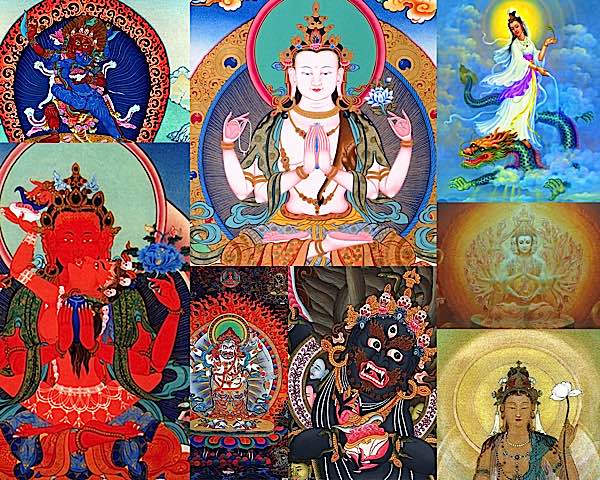
Three Families of Compassion, Wisdom and Activity
Although there are more aspects of practice than the main three — compassion, wisdom and power — the focus of this feature is on the core three. It can also be confusing to speak in this context of the Buddha families because the five Dhyani Buddha Families each have a specific “wisdom” of focus for their family — so we are also more or less excluding the five Dhyani Buddhas here. [In this feature, we’re not discussing the Dhyani Buddhas — please see our previous series on the Buddha Families>>]
Here, we are simplifying, only focusing on the three classic groupings of Enlightened beings (families being a metaphorical label) with focus on:
- Power and Activity — Vajrasattva’s Family
- Compassion — Amitabha’s Family
- Wisdom — Manjushri’s Family
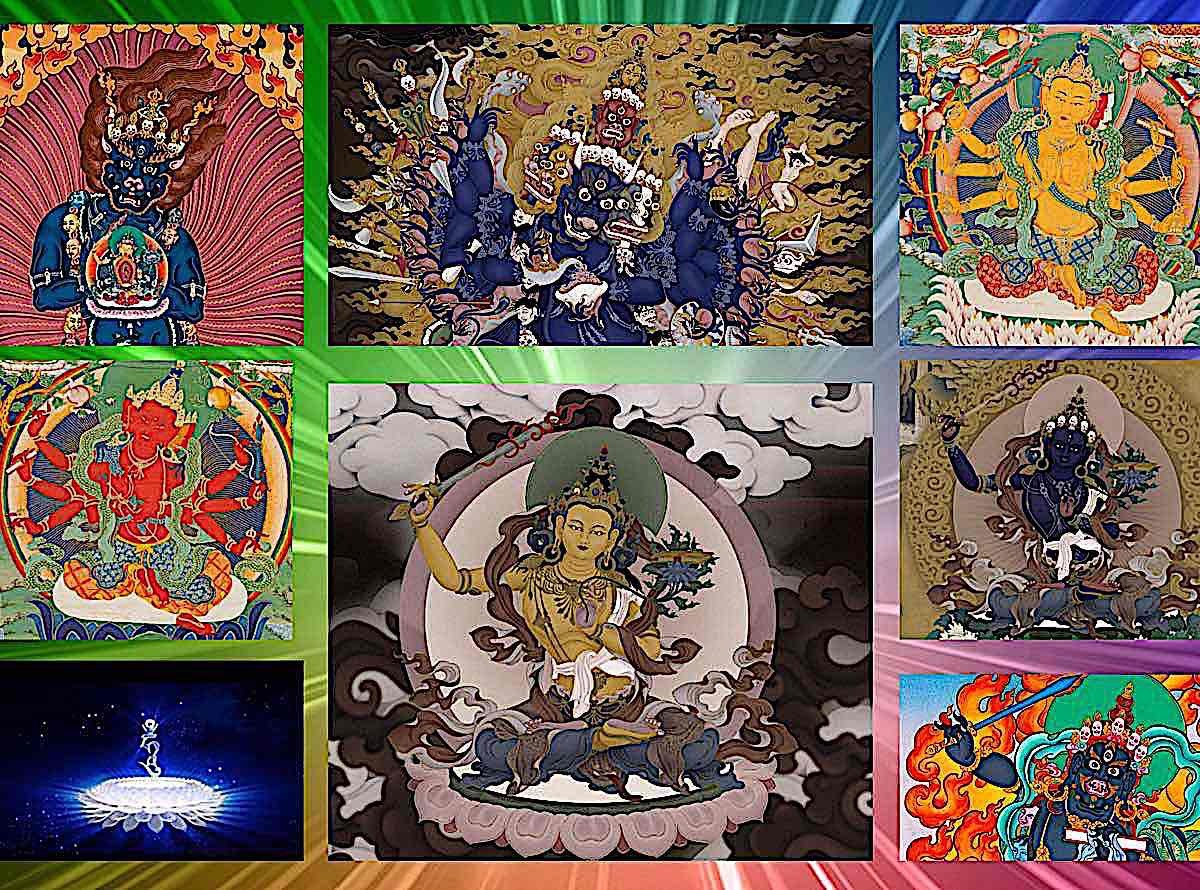
Three Seed Syllables Om Ah Hum
These can be roughly correlated to the all-important and sacred mantra syllables OM AH HUM.
- OM — representing “Enlightened Body” — related to all our karmic activities of body and power.
- AH — representing “Enlightened Speech” — which is the main instrument of Compassion.
- HUM (Hung) — representing “Enlightened Mind” — which is prajna or wisdom
To simplify in this feature, we’re only focusing on these three areas, not all the many Buddha families. It’s important to note that there is more than one Buddha, Bodhisattva, Heruka and Dakini that represents each of these. We’re only highlighting the best-known emanations.
For an introduction to the Three Great Ones, the Bodhisattvas of Compassion, Wisdom and Power — and their mantras — enjoy this mini-documentary followed by chanted mantras with visualization images o Avalokiteshvara, Manjushri and Vajrapani:
The Family Groups
We’ll explore these in-depth below, or with links to full features on specific topics — although it’s important to emphasize that certain lineages may have different family associations (be guided by your own lineage teachings.) Since all Buddhas are ultimately one, there is no contradiction. As a general summary, here are the family groups as associated with Compassion, Wisdom, and Power with the most important emanation in each class of Buddha, Bodhisattva, Heruka and Dakini:
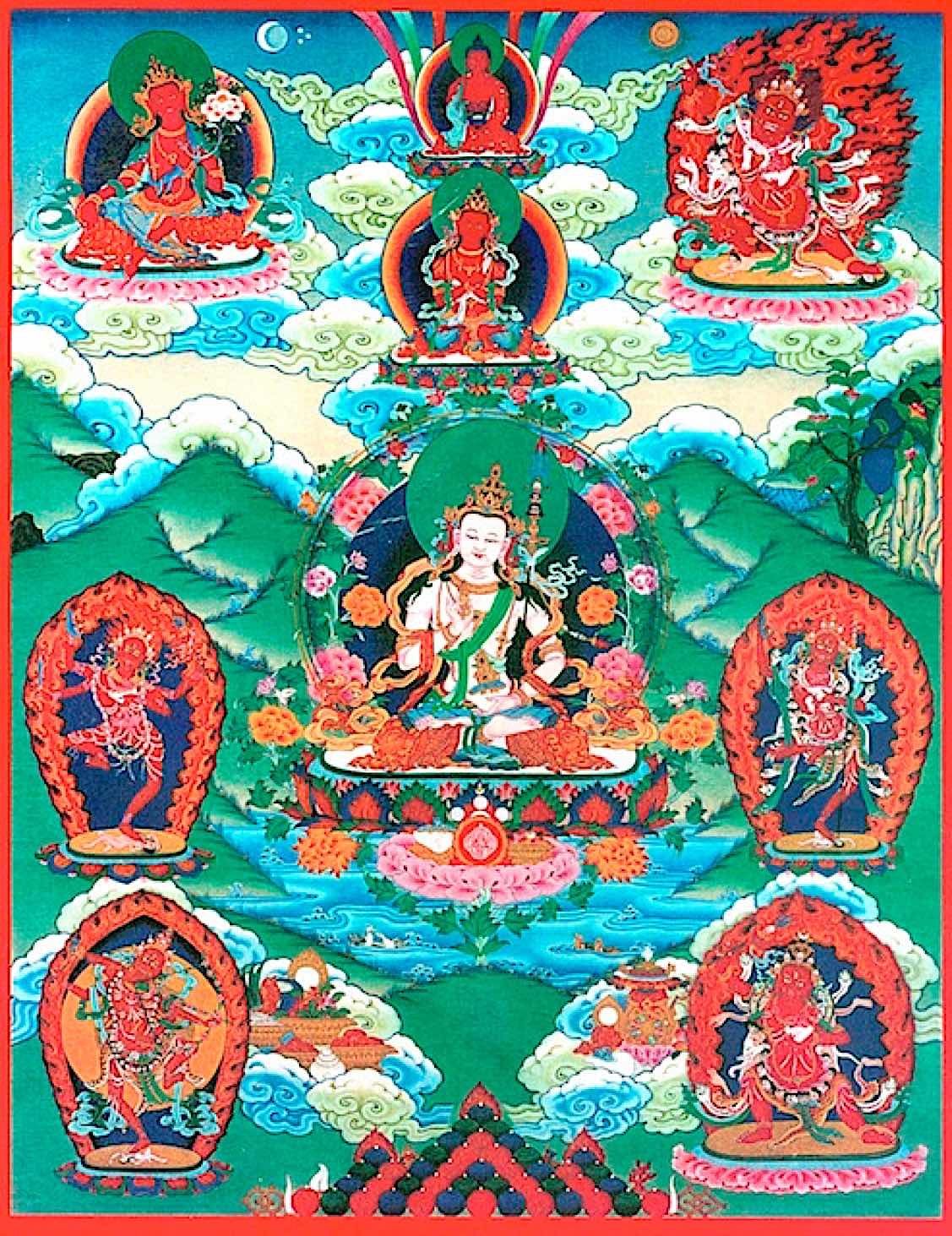
Compassion
Buddha: Amitabha
Bodhisattva: Avalokiteshvara
Heruka: Daka Hayagriva
Wisdom Dakini: Vajrayogini (or Padma Dakini)
The most wrathful form of Compassion is Hayagriva, the Heruka of Amitabha/Chenrezig:
Wisdom
Buddha: Vairochana, the “Dharmakaya” Buddha (since Yamantaka/Manjushri are of his family), although sometimes Akshobya (mirror like wisdom (Sanskrit: ādarśa-jñāna; re: Panchajnana)); it can depend on the specific wisdom of focus (each of the Five Dhyani Buddhas focuses on a specific wisdom)
Bodhisattva: Manjushri
Heruka: Yamantaka
Wisdom Dakini: Vajra Dakini
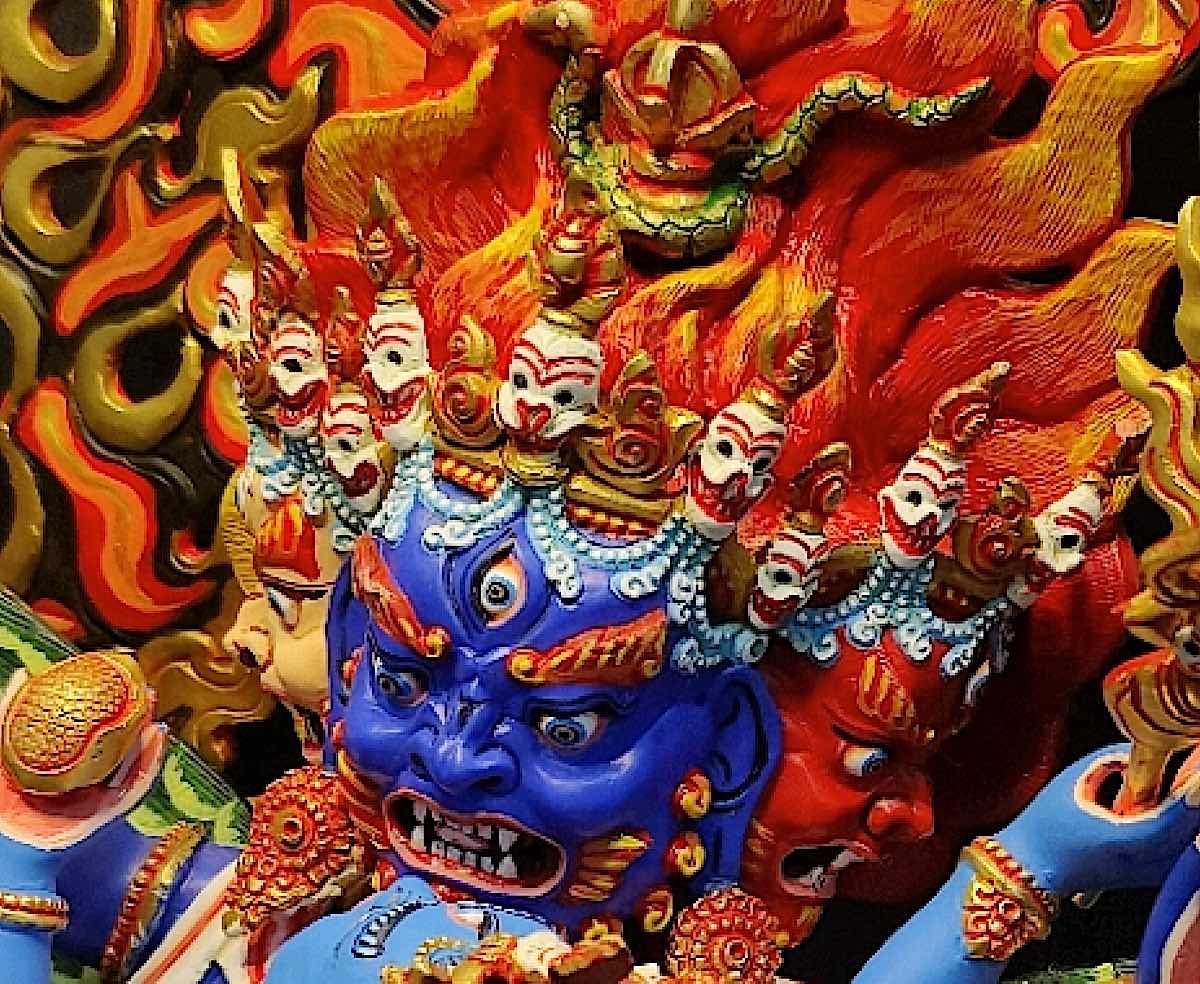
Power (Karma Activity)
Buddha: Vajrasattva is the main “Buddha” associated, although it can be confusing because Amoghasiddhi is also the head of the “Karma” or activity family and he appears in visualizations of Vajrakilaya.
Bodhisattva: Vajrapani
Heruka: Vajrakilaya
Wisdom Dakini: Buddha Dakini
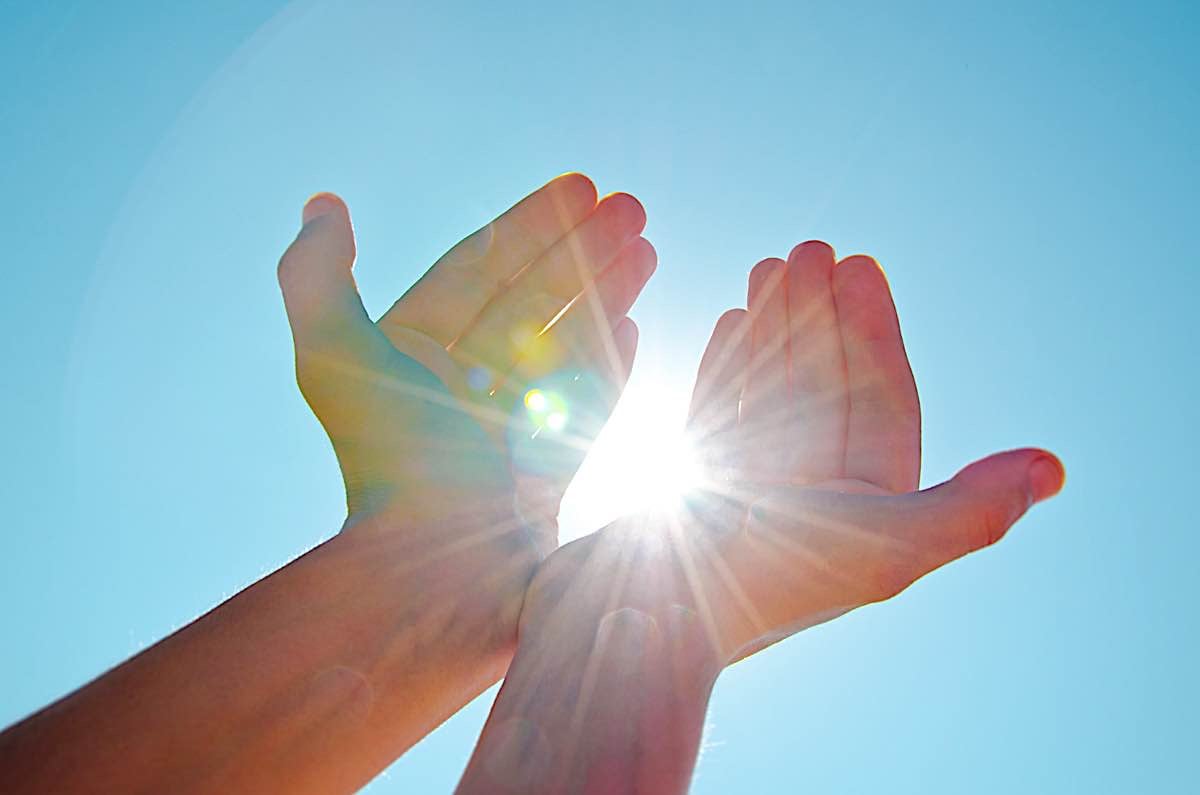
Buddha is like the Sun
One way to think metaphorically about it is that Buddha is as the sun. From our limited perspective, we see the sun as a big bright light in the sky. But if we could see things from the sun’s perspective, we would realize that the sun also emits an unimaginably vast array of energies and particles — including heat, light, X-rays, gamma rays, ultraviolet radiation — that pervade and permeate the entire solar system. And from an even broader perspective, we would realize that the sun is just one star among billions in our galaxy, which is just one of the billions of galaxies in the observable universe.
Similarly, Buddha is an unimaginably vast and powerful being who manifests in an infinite variety of ways to help beings at different levels. Usually, we “label” this vast concept of Dharmakaya “Buddha” [see the “Three Bodies” below] — such as Samantabadhra or Vajradhara (depending on our labeling “system” and lineage). In some lineages, this can be Vajrasattva or Vairochana. These are not contradictions — as in Buddhism, all Buddhas are thought of as aspects of one Buddha.
From our limited perspective, we may see Buddha as a single form — such as the historical Buddha Shakyamuni or the Buddha of Compassion Avalokiteshvara. But from Buddha’s perspective, he manifests in an infinite variety of forms to meet the needs of beings at different levels. This is to benefit the preferences and karmas of various beings in Samsara.
To make this easier relatively speaking — dualistically speaking — we tend to group these concepts or emanations as families. (For example the Five Dhyani Buddhas, which we covered separately here>>) Our metaphorical labels, in terms of the “families” of compassion, wisdom and power is “Buddha.”
Mantra of the Buddha of the Compassion family, Amitabha. Amitabha is the Buddha of Infinite Light, associated with the West, the Lotus, and Compassion:
Head of the family — Buddha
They are always both male and female — often visualized as Buddha and Consort of Father and Mother union. Even when visualized as a solitary Buddha, this is still considered a complete union of the two (helping us to overcome notions of dualism.) For example, in the Padma compassion family this Buddha Amitabha and Buddha Pandaravasini (mother and father, both Buddha as one). Even though we say just “Amitabha” this is actually Amitabha/Pandaravasini.
Children of the family — Bodhisattva
These are not physical offspring, children being a metaphor. For example, in the same Padma compassion family of Amitabha, this is Avalokiteshvara (Chenrezig)
Chenrezig or Avalokiteshvara is the Bodhisattva of the Lotus or Compassion family of Amitabha. His mantra is among the best known in the world, and brings peace and compassion. Listen to this stirring and beautiful chant of Om Mani Padme Hum by amazing Yoko Dharma:
Hero of the family — Heruka
The most active conquering champion of the family who actively and energetically embodies all power of the family — but trained with super-charged black belts to the highest degree. For example, in the Padma family, this is Hayagriva Heruka.
Vajrakilaya is the “heruka” or hero of the Action/Karma Power family, an emanation of none other than Vajrasattva. His mantra and practice is effective at removing all obstacles:
Wise elder of the family — Dakini
Although we visualize Dakinis as young, they embody the greatest of Wisdom, the Wisdom of Shunyata; so, though ageless, they have the role of the wise elder in our metaphor. For example, in the Padma family, the highest Dakini would be Vajrayogini, the Sarvadakini. She also emanates as Padma Dakina and countless other aspects or forms.
The wisdom Dakinis are the Dakinis who represent the wisdom of each of the Buddha Families. Their mantras, chanted by the amazing Yoko Dharma:
Buddhas — the head of the family
Buddhas — and all of the others — are fully Enlightened Beings. Although in ultimate terms, all Buddhas are Buddha — of One Essence — for those of us struggling with dualistic thoughts, the Buddhas manifest in different forms. These tend to be “labeled” as Buddha Families — not just the Dhyani Buddhas, but other specific groups focused on certain areas of focus. For example, the “Compassion” family is the Lotus or Padma family headed by the father, Buddha Amitabha and the mother, Buddha Pandaravasini.
For the purposes of this feature, we call the Buddha emanations the “head of the family” — the “family” patriarch and matriarch (together) of a Buddha family. For example, Tara is seen dualistically as the female Buddha of the activity family; Amoghasiddhi is seen dualistically as the male Buddha of the Activity family — but they are, in essence, one, since Wisdom and Compassion may never be separated. These “Enlightened families” are dualistically thought of as families to represent a conceptual focus.
The Buddhas in the three main areas of practice — Compassion, Wisdom and Power (Activity or Karma) are:
- Compassion — Amitabha
- Wisdom — Vairocana (Vairochana)
- Power (karma) — Vajrasattva
A video all about glorious Vajrasattva, the ultimate Buddha of purification and karma:
The world of Bodhisattvas: the Three Great Ones
These three — compassion, wisdom and activities — especially manifest in our world as Bodhisattvas — who remain in our dualistic world to help us. Compassion manifests as Avalokiteshvara, Wisdom as Manjushri, and Activities (sometimes called “Power”) as Vajrapani.
Each of these are also associated with peaceful Buddha forms. It would be a mistake to think of these manifestations as separate. They are different aspects of the same Enlightened concept. Similarly, it is a mistake to assume that Compassion is separate from Wisdom or Activity. They are mutually co-dependent. You cannot express compassion without activity, and wisdom is also expressed as activities.
The Bodhisattvas in the three main areas of practice — Compassion, Wisdom and Power (Activity or Karma) are:
- Compassion — Avalokitesvara (Avalokiteshvara, Chenrezig, Guan Yin, Kanon)
- Wisdom — Manjushri
- Power (karma) — Vajrapani
Why do we need wrathful deities, such as the Herukas? In this documentary video we explore the world of the “wrathful” deities:
The world of Herukas: the Three Heroes
There are more than three herukas — in most lineages, we honor eight main herukas (sometimes thought of as “blood drinkers” due to their wrath, but normally thought of as the “heroes” or most active highest-yoga aspects.
The three main herukas that represent the Buddha families and their specific areas of focus are:
Compassion — Hayagriva Heruka (Padma family)
Wisdom — Yamantaka Heruka (Vairochana family)
Power (karma) — Vajrakilaya Heruka (Vajrasattva family) — Vajrakilaya is also thought of as the Heruka of “all the activities of all the Buddhas and Bodhisattvas.”
A mini-documentary on the Wisdom Dakinis, followed by the mantras of all of the five Wisdom Dakinis:
The world of Dakinis: the Three Wisdoms
There are more than three dakinis, but the three that represent the Buddha families and their specific areas of focus are:
Compassion — Vajrayogini (Padma family)
Wisdom — Buddha Dakini (Vairochana family)
Power — Karma Dakini, (Vajrasattva family)
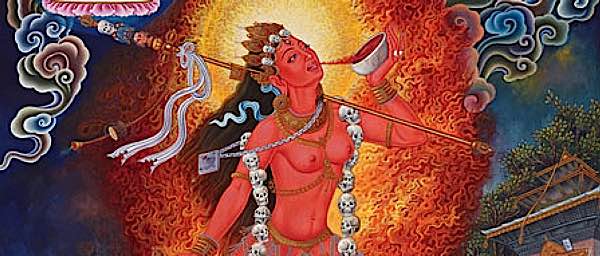
Vajrayogini, the Sarva Dakini, supreme dakini, and supreme wisdom in the compassion family.
The Three Buddha Bodies
It is helpful to understand that the Buddha, Bodhisattva, Heruka and Dakini aspects are all expressions of the same Buddha nature — a Buddha Nature that each of us has (albeit obscured by our dualistic thinking). Often these concepts of Wisdom, Compassion and Activity are associated with teh “The Three Buddha Bodies” — although that’s a bigger topic, beyond the scope of this feature — which are:
- The Dharmakaya Buddha Body (Wisdom)
- The Sambhogakaya Buddha Body (Compassion)
- The Nirmanakaya Buddha Body (Activity)
The Dharmakaya Buddha Body is the ultimate body of the Buddha — the Buddha nature that we all have. It is beyond form, beyond time and space and beyond our dualistic concepts. It is sometimes called “the formless Buddha body” or “the Buddha nature.” It is associated with “wisdom” generally since it’s the ultimate manifestation, the understanding of Shunyata, the Dharamadatu Wisdom conceptualized.
The Sambhogakaya Buddha Body is the Buddha form that appears in visions to those who have attained a certain level of spiritual development. It is a Buddha form that is beyond our normal dualistic concepts of form, but which can appear in various forms to help us. This can be most aligned with Compassion since it is the compassion of the Buddhas that manifests to help us on this level.
The Nirmanakaya Buddha Body is the Buddha form that appears in our world in a physical body to undertake activities (of wisdom and compassion). The most famous example is, of course, the historical Buddha, Siddhartha Gautama. This is the “karma” or activity level of Buddha manifestation.
The ultimate nature of reality
These Three Buddha Bodies represent the ultimate nature of reality — that everything is Buddha. And they also represent the three main aspects of practice in Buddhism: Compassion, Wisdom and Activity.
When we think of the Buddha, we often think only of the Nirmanakaya Buddha form of Siddhartha Gautama. But it is important to remember that the Buddha is much more than that. The Buddha is the Dharmakaya Buddha — the ultimate nature of reality itself. And the Buddha is also the Sambhogakaya Buddha — the form that appears in visions to help us.
The Three Buddha Bodies are also sometimes called “The Three kayas” or “The Trikaya.”
In summary, then, the three main aspects of practice in Buddhism are: Compassion, Wisdom and Activity. These manifest in our world as:
- Buddha
- Bodhisattva
- Heruka
- Dakini
They also manifest in many other ways, as highlighted in this feature. And these all represent different aspects of the same Buddha nature — the ultimate reality that everything is Buddha.

